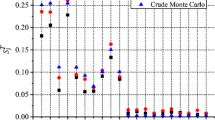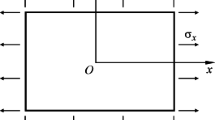Abstract
In this paper, a framework for the stochastic progressive failure analysis (PFA) of fiber-reinforced composites is presented. The nonlinear responses of composite structures are hugely influenced by the randomness in material properties of plies, thereby yielding significantly different responses compared with that with deterministic simulations. Moreover, performing PFA using finite element analysis (FEA) is a computationally intensive process that becomes unaffordable while performing uncertainty analysis that requires numerous FEA runs. So, to alleviate this computational cost while maintaining an acceptable accuracy, an efficient technique called polynomial chaos expansion (PCE) was implemented. Another advantage of PCE is that it allows performing global sensitivity analysis (GSA) to estimate the influence of the random inputs on the stochastic responses as a post-processing step without any additional cost. The effects of randomness in material properties on the first ply failure load and ultimate failure responses of a composite laminate were compared with the framework using PCE as well as 5000 LHS simulations and the results underlined the cost-effectiveness as well as the high accuracy of PCE. Moreover, the GSA successfully identified the influential random material properties that correlated well with the failure modes. Thus, the presented approach and the results of this study will be instrumental in understanding the failure as well as improving the design of composite structures.




















Similar content being viewed by others
References
Ambur DR, Jaunky N, Hilburger M, Davila CG (2004) Progressive failure analyses of compression-loaded composite curved panels with and without cutouts. Compos Struct 65(2):143–155
Camanho P, Maimí P, Dávila C (2007) Prediction of size effects in notched laminates using continuum damage mechanics. Compos Sci Technol 67(13):2715–2727
Chang FK, Chang KY (1987) A progressive damage model for laminated composites containing stress concentrations. J Compos Mater 21(9):834–855
Chang FK, Lessard L, Tang JM (1988) Compression response of laminated composites containing an open hole. SAMPE Q;(United States) 19(4)
Chen JF, Morozov EV, Shankar K (2014) Progressive failure analysis of perforated aluminium/CFRP fibre metal laminates using a combined elastoplastic damage model and including delamination effects. Compos Struct 114:64–79
Choi SK, Grandhi R, Canfield RA (2006) Reliability-based structural design. Springer Science & Business Media
Crestaux T, Le maıtre O, Martinez JM (2009) Polynomial chaos expansion for sensitivity analysis. Reliab Eng Syst Saf 94(7):1161–1172
Cruz ME, Patera AT (1995) A parallel Monte-Carlo finite-element procedure for the analysis of multicomponent random media. Int J Numer Methods Eng 38(7):1087–1121
Daniel IM (2007) Failure of composite materials. Strain 43(1):4–12
Dey S, Mukhopadhyay T, Adhikari S (2015) Stochastic free vibration analyses of composite shallow doubly curved shells–a kriging model approach. Compos B Eng 70:99–112
Dey S, Mukhopadhyay T, Adhikari S (2017) Metamodel based high-fidelity stochastic analysis of composite laminates: a concise review with critical comparative assessment. Compos Struct 171:227–250
Elder D, Verdaasdonk A, Thomson R (2008) Fastener pull-through in a carbon fibre epoxy composite joint. Compos Struct 86(1):291–298. fourteenth International Conference on Composite Structures
Gadade AM, Lal A, Singh B (2016) Stochastic progressive failure analysis of laminated composite plates using Puck’s failure criteria. Mech Adv Mater Struct 23(7):739–757
Garnich MR, Akula VMK (2009) Review of degradation models for progressive failure analysis of fiber reinforced polymer composites. Appl Mech Rev 62(1):010801
Gautschi W (2004) Orthogonal polynomials. Oxford University Press, Oxford
Ghanem R, Spanos PD (1990) Polynomial chaos in stochastic finite elements
Günel M, Kayran A (2013) Non-linear progressive failure analysis of open-hole composite laminates under combined loading. J Sandw Struct Mater 15(3):309–339
Hinton MJ, Kaddour AS, Soden PD (2002) A comparison of the predictive capabilities of current failure theories for composite laminates, judged against experimental evidence. Compos Sci Technol 62 (12-13):1725–1797
Hinton MJKA, Kaddour AS, Soden PD (2004) Failure criteria in fibre reinforced polymer composites: the world-wide failure exercise. Elsevier
Hosder S, Walters R, Perez R (2006) A non-intrusive polynomial chaos method for uncertainty propagation in CFD simulations. In: 44th AIAA aerospace sciences meeting and exhibit, p 891
Hosder S, Walters RW, Balch M (2010) Point-collocation nonintrusive polynomial chaos method for stochastic computational fluid dynamics. AIAA J 48(12):2721–2730
Icardi U, Locatto S, Longo A (2007) Assessment of recent theories for predicting failure of composite laminates. Appl Mech Rev 60(2):76–86
Kamiński M, Kleiber M (2000) Perturbation based stochastic finite element method for homogenization of two-phase elastic composites. Comput Struct 78(6):811–826
Kanouté P, Boso DP, Chaboche JL, Schrefler BA (2009) Multiscale methods for composites: a review. Arch Comput Methods Eng 16(1):31–75
Kleiber M, Hien TD (1992) The stochastic finite element method: basic perturbation technique and computer implementation. Wiley
Lee CS, Kim JH, Kim SK, Ryu DM, Lee JM (2015) Initial and progressive failure analyses for composite laminates using Puck failure criterion and damage-coupled finite element method. Compos Struct 121:406–419
Li HS, Gu RJ, Zhao X (2017) Global sensitivity analysis of load distribution and displacement in multi-bolt composite joints. Compos B Eng 116:200–210
Liu G, Tay TE, Tan VBC (2010) Failure progression and mesh sensitivity analyses by the plate element-failure method. J Compos Mater 44(20):2363–2379
Liu PF, Zheng J (2008) Progressive failure analysis of carbon fiber/epoxy composite laminates using continuum damage mechanics. Mater Sci Eng A 485(1-2):711–717
Liu WK, Belytschko T, Mani A (1986) Probabilistic finite elements for nonlinear structural dynamics. Comput Methods Appl Mech Eng 56:61–81
Lopes CS, Camanho PP, Gürdal Z, Tatting BF (2007) Progressive failure analysis of tow-placed, variable-stiffness composite panels. Int J Solids Struct 44(25-26):8493–8516
McCartney LN (2005) Energy-based prediction of progressive ply cracking and strength of general symmetric laminates using an homogenisation method. Compos A: Appl Sci Manuf 36(2):119–128
MSC (2007) MSC Nastran 2007 r1, Implicit nonlinear (SOL 600) user’s guide. MSC.Software
Murugesan N, Rajamohan V (2017) Prediction of progressive ply failure of laminated composite structures: a review. Arch Comput Methods Eng 24(4):841–853
Navaid MR (2010) Global sensitivity analysis of parameters in Puck’s failure theory for laminated composites. PhD thesis, Engineering
Pal P, Bhattacharyya S (2007) Progressive failure analysis of cross-ply laminated composite plates by finite element method. J Reinf Plast Compos 26(5):465–477
Pal P, Ray C (2002) Progressive failure analysis of laminated composite plates by finite element method. J Reinf Plast Compos 21(16):1505–1513
Puck A, Schürmann H (2004) Failure analysis of FRP laminates by means of physically based phenomenological models. In: Failure Criteria in Fibre-Reinforced-Polymer Composites. Elsevier, pp 832–876
Reddy JN (2003) Mechanics of laminated composite plates and shells: theory and analysis. CRC press
Reddy Y, Moorthy CD, Reddy J (1995) Non-linear progressive failure analysis of laminated composite plates. Int J Nonlin Mech 30(5):629–649
Romanowicz M (2010) Progressive failure analysis of unidirectional fiber-reinforced polymers with inhomogeneous interphase and randomly distributed fibers under transverse tensile loading. Compos A: Appl Sci Manuf 41(12):1829–1838
Sakata S, Ashida F, Kojima T, Zako M (2008a) Influence of uncertainty in microscopic material property on homogenized elastic property of unidirectional fiber reinforced composites. Theor Appl Mech Japan 56:67–76
Sakata S, Ashida F, Zako M (2008b) Stochastic response analysis of FRP using the second-order perturbation-based homogenization method. J Solid Mech Mater Eng 2(1):70–81
Saltelli A, Chan K, Scott M, et al. (2000) Sensitivity analysis probability and statistics series. Wiley, New York
Sepahvand K (2016) Spectral stochastic finite element vibration analysis of fiber-reinforced composites with random fiber orientation. Compos Struct 145:119–128
Shaw A, Sriramula S, Gosling PD, Chryssanthopoulos MK (2010) A critical reliability evaluation of fibre reinforced composite materials based on probabilistic micro and macro-mechanical analysis. Compos B Eng 41(6):446–453
Sleight DW (1999) Progressive failure analysis methodology for laminated composite structures, NASA/TP-1999-209107,. Tech. rep
Soden PD, Kaddour AS, Hinton MJ (2004) Recommendations for designers and researchers resulting from the world-wide failure exercise. In: Failure criteria in fibre-reinforced-polymer composites. Elsevier, pp 1223–1251
Su Z, Tay T, Ridha M, Chen B (2015) Progressive damage modeling of open-hole composite laminates under compression. Compos Struct 122:507–517
Sudret B (2008) Global sensitivity analysis using polynomial chaos expansions. Reliab Eng Syst Saf 93(7):964–979
Sun X, Tong L, Chen H (2001) Progressive failure analysis of laminated plates with delamination. J Reinf Plast Compos 20(16):1370–1389
Szeg G (1939) Orthogonal polynomials, vol 23. American Mathematical Soc
Tan S, Nuismer R (1989) A theory for progressive matrix cracking in composite laminates. J Compos Mater 23(10):1029–1047
Tan SC, Perez J (1993) Progressive failure of laminated composites with a hole under compressive loading. J Reinf Plast Compos 12(10):1043–1057
Tay TE, Liu G, Tan VBC, Sun XS, Pham DC (2008) Progressive failure analysis of composites. J Compos Mater 42(18):1921–1966
Thapa M, Mulani SB, Walters RW (2018a) A new non-intrusive polynomial chaos using higher order sensitivities. Comput Methods Appl Mech Eng 328:594–611
Thapa M, Mulani SB, Walters RW (2018b) Variance based adaptive-sparse polynomial chaos with adaptive sampling. In: 2018 AIAA Non-deterministic approaches conference, p 2168
Thapa M, Jony B, Vishe N, Mulani SB, Roy S (2019a) Comparison of numerical and experimental study of mode-I interlaminar fracture of self-healing composites using cohesive zone modeling. In: Proceedings of the American Society for Composites—Thirty-fourth Technical Conference
Thapa M, Mulani SB, Walters RW (2019b) Stochastic multi-scale modeling of carbon fiber reinforced composites with polynomial chaos. Compos Struct 213:82–97
Thapa M, Mulani SB, Walters RW (2019c) Uncertainty quantification: advances in research and applications. Nova
Thapa M, Mulani SB, Walters RW (2020) Adaptive weighted least-squares polynomial chaos expansion with basis adaptivity and sequential adaptive sampling. Comput Methods Appl Mech Eng 360:112759
Vallmajó O, Cózar I, Furtado C, Tavares R, Arteiro A, Turon A, Camanho P (2019) Virtual calculation of the b-value allowables of notched composite laminates. Compos Struct 212:11–21
Wiener N (1938) The homogeneous chaos. Am J Math 60(4):897–936
Xiu D, Karniadakis GE (2002) The Wiener–Askey polynomial chaos for stochastic differential equations. SIAM J Sci Comput 24(2):619–644
Zhi J, Tay TE (2018) Computational structural analysis of composites with spectral-based stochastic multi-scale method. Multiscale Model Simul 1(2):103–118
Zhou XY, Gosling PD, Pearce CJ, Ullah Z, Kaczmarczyk L (2016) Perturbation-based stochastic multi-scale computational homogenization method for woven textile composites. Int J Solids Struct 80:368–380
Zhu C, Zhu P, Lu J (2018) Global sensitivity analysis for the elastic properties of unidirectional carbon fibre reinforced composites based on metamodels. Polym Polym Compos 26(3):205–221
Acknowledgments
This research was carried out while the first author was on a Graduate Council Fellowship (GCF) during his Ph.D. at the University of Alabama. The authors would like to thank the Research Grants Committee (RGC), Graduate Council Fellowship, the Remote Sensing Center, and the Department of Aerospace Engineering and Mechanics at The University of Alabama, Tuscaloosa for their kind support.
Author information
Authors and Affiliations
Corresponding author
Ethics declarations
Conflict of interest
The authors declare that they have no conflict of interest.
Additional information
Responsible Editor: Helder C. Rodrigues
Publisher’s note
Springer Nature remains neutral with regard to jurisdictional claims in published maps and institutional affiliations.
Replication of results
The MATLAB codes for the presented framework and finite element analysis files for the application problems generated during this study are available in the GitHub repository, https://github.com/mthapa7/SAMO_UQGSAPFA_CODES.git.
Rights and permissions
About this article
Cite this article
Thapa, M., Paudel, A., Mulani, S.B. et al. Uncertainty quantification and global sensitivity analysis for progressive failure of fiber-reinforced composites. Struct Multidisc Optim 63, 245–265 (2021). https://doi.org/10.1007/s00158-020-02690-5
Received:
Revised:
Accepted:
Published:
Issue Date:
DOI: https://doi.org/10.1007/s00158-020-02690-5




